Menu Planning and Product Development Report (HND, Jan-Apr 2019)
VerifiedAdded on 2020/10/05
|10
|3076
|126
Report
AI Summary
This report provides a detailed analysis of menu planning and product development within the hospitality industry, using Prezzo, a UK-based Italian restaurant chain, as a case study. The report begins by outlining the principles and factors of recipe development, emphasizing taste, quality, customer preferences, and resource availability. It then explores factors influencing menu planning decisions, such as target customers, budgeting, restaurant theme, and lifestyle considerations. The report also examines various service methods, including family style, cafeteria, and buffet service, and their influencing factors. The core of the report delves into the stages of menu product development planning, including knowing the occasion, recipe planning, recipe trials, and final menu presentation. It also considers the influence of social, economic, and domestic factors on the development process, with a focus on Prezzo's strategies. The report concludes with a summary of findings and recommendations for implementing new food concepts, offering valuable insights for hospitality management students.
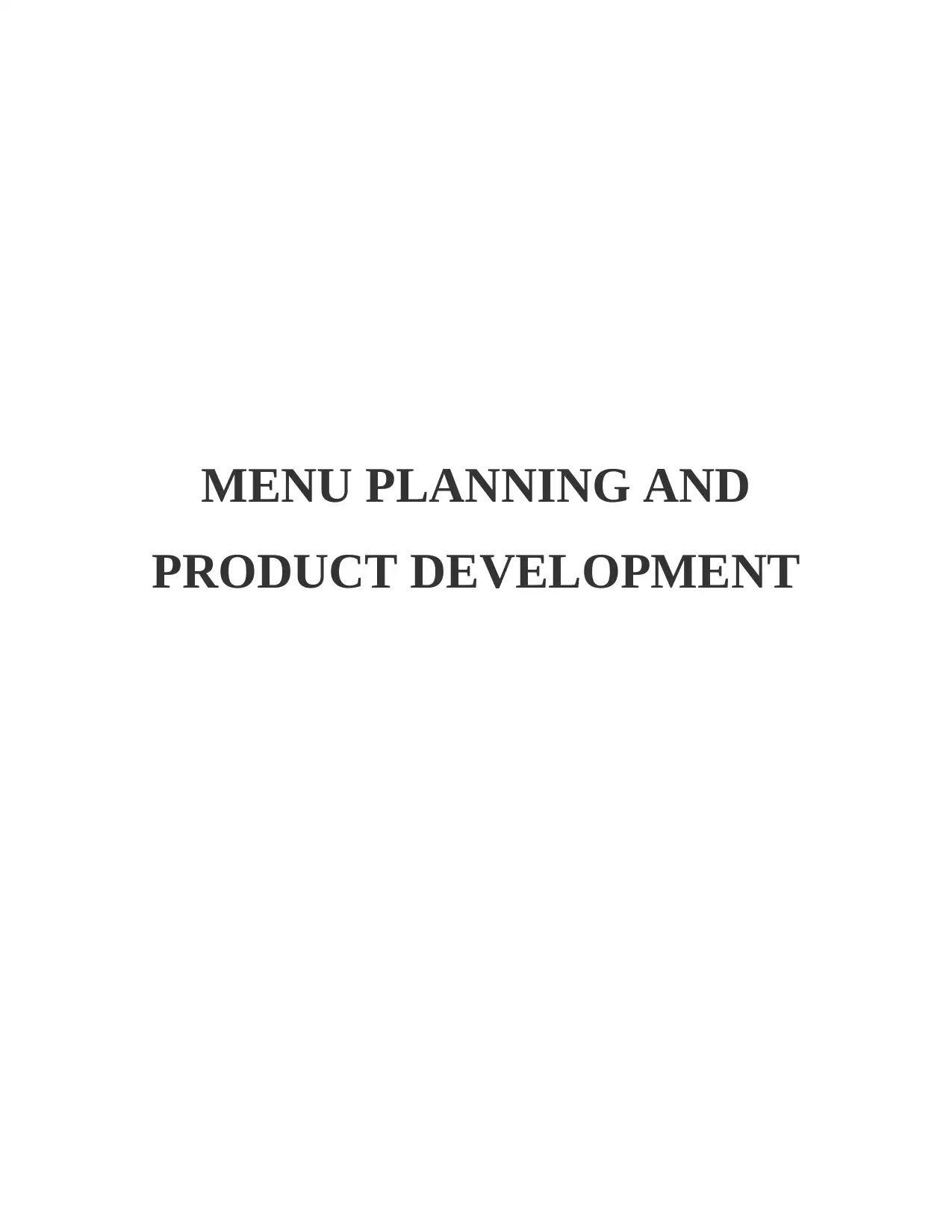
MENU PLANNING AND
PRODUCT DEVELOPMENT
PRODUCT DEVELOPMENT
Paraphrase This Document
Need a fresh take? Get an instant paraphrase of this document with our AI Paraphraser
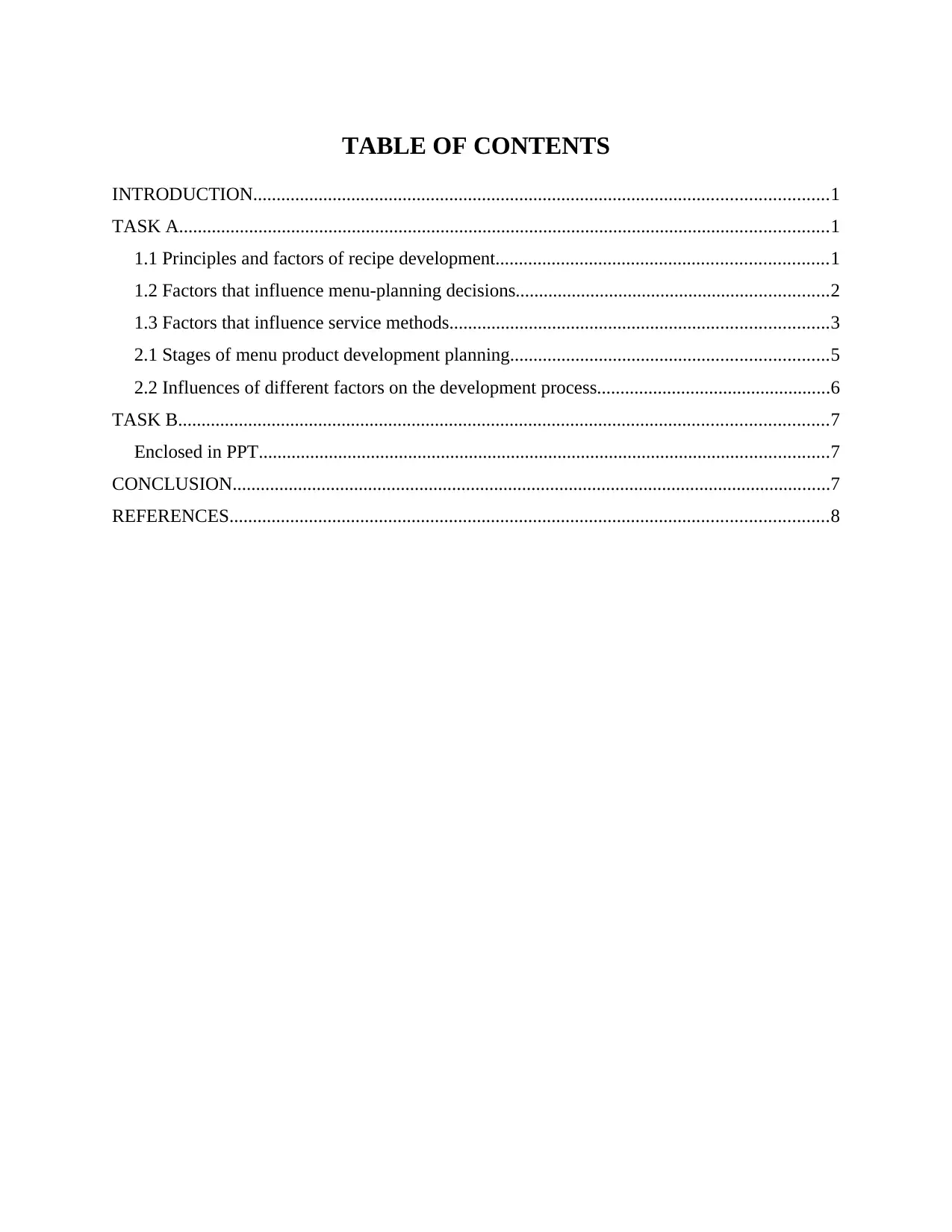
TABLE OF CONTENTS
INTRODUCTION...........................................................................................................................1
TASK A...........................................................................................................................................1
1.1 Principles and factors of recipe development.......................................................................1
1.2 Factors that influence menu-planning decisions...................................................................2
1.3 Factors that influence service methods.................................................................................3
2.1 Stages of menu product development planning....................................................................5
2.2 Influences of different factors on the development process..................................................6
TASK B...........................................................................................................................................7
Enclosed in PPT..........................................................................................................................7
CONCLUSION................................................................................................................................7
REFERENCES................................................................................................................................8
INTRODUCTION...........................................................................................................................1
TASK A...........................................................................................................................................1
1.1 Principles and factors of recipe development.......................................................................1
1.2 Factors that influence menu-planning decisions...................................................................2
1.3 Factors that influence service methods.................................................................................3
2.1 Stages of menu product development planning....................................................................5
2.2 Influences of different factors on the development process..................................................6
TASK B...........................................................................................................................................7
Enclosed in PPT..........................................................................................................................7
CONCLUSION................................................................................................................................7
REFERENCES................................................................................................................................8
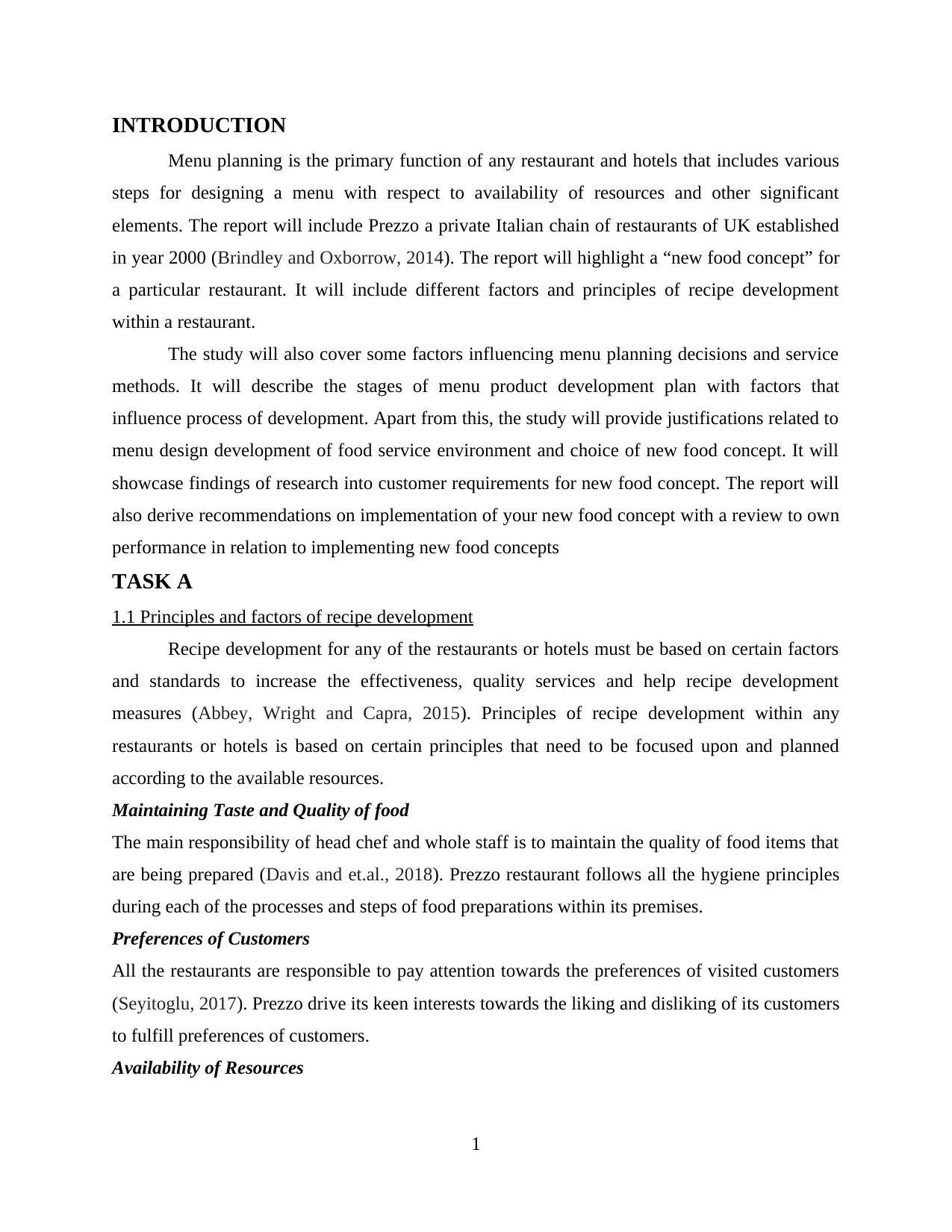
INTRODUCTION
Menu planning is the primary function of any restaurant and hotels that includes various
steps for designing a menu with respect to availability of resources and other significant
elements. The report will include Prezzo a private Italian chain of restaurants of UK established
in year 2000 (Brindley and Oxborrow, 2014). The report will highlight a “new food concept” for
a particular restaurant. It will include different factors and principles of recipe development
within a restaurant.
The study will also cover some factors influencing menu planning decisions and service
methods. It will describe the stages of menu product development plan with factors that
influence process of development. Apart from this, the study will provide justifications related to
menu design development of food service environment and choice of new food concept. It will
showcase findings of research into customer requirements for new food concept. The report will
also derive recommendations on implementation of your new food concept with a review to own
performance in relation to implementing new food concepts
TASK A
1.1 Principles and factors of recipe development
Recipe development for any of the restaurants or hotels must be based on certain factors
and standards to increase the effectiveness, quality services and help recipe development
measures (Abbey, Wright and Capra, 2015). Principles of recipe development within any
restaurants or hotels is based on certain principles that need to be focused upon and planned
according to the available resources.
Maintaining Taste and Quality of food
The main responsibility of head chef and whole staff is to maintain the quality of food items that
are being prepared (Davis and et.al., 2018). Prezzo restaurant follows all the hygiene principles
during each of the processes and steps of food preparations within its premises.
Preferences of Customers
All the restaurants are responsible to pay attention towards the preferences of visited customers
(Seyitoglu, 2017). Prezzo drive its keen interests towards the liking and disliking of its customers
to fulfill preferences of customers.
Availability of Resources
1
Menu planning is the primary function of any restaurant and hotels that includes various
steps for designing a menu with respect to availability of resources and other significant
elements. The report will include Prezzo a private Italian chain of restaurants of UK established
in year 2000 (Brindley and Oxborrow, 2014). The report will highlight a “new food concept” for
a particular restaurant. It will include different factors and principles of recipe development
within a restaurant.
The study will also cover some factors influencing menu planning decisions and service
methods. It will describe the stages of menu product development plan with factors that
influence process of development. Apart from this, the study will provide justifications related to
menu design development of food service environment and choice of new food concept. It will
showcase findings of research into customer requirements for new food concept. The report will
also derive recommendations on implementation of your new food concept with a review to own
performance in relation to implementing new food concepts
TASK A
1.1 Principles and factors of recipe development
Recipe development for any of the restaurants or hotels must be based on certain factors
and standards to increase the effectiveness, quality services and help recipe development
measures (Abbey, Wright and Capra, 2015). Principles of recipe development within any
restaurants or hotels is based on certain principles that need to be focused upon and planned
according to the available resources.
Maintaining Taste and Quality of food
The main responsibility of head chef and whole staff is to maintain the quality of food items that
are being prepared (Davis and et.al., 2018). Prezzo restaurant follows all the hygiene principles
during each of the processes and steps of food preparations within its premises.
Preferences of Customers
All the restaurants are responsible to pay attention towards the preferences of visited customers
(Seyitoglu, 2017). Prezzo drive its keen interests towards the liking and disliking of its customers
to fulfill preferences of customers.
Availability of Resources
1
⊘ This is a preview!⊘
Do you want full access?
Subscribe today to unlock all pages.

Trusted by 1+ million students worldwide
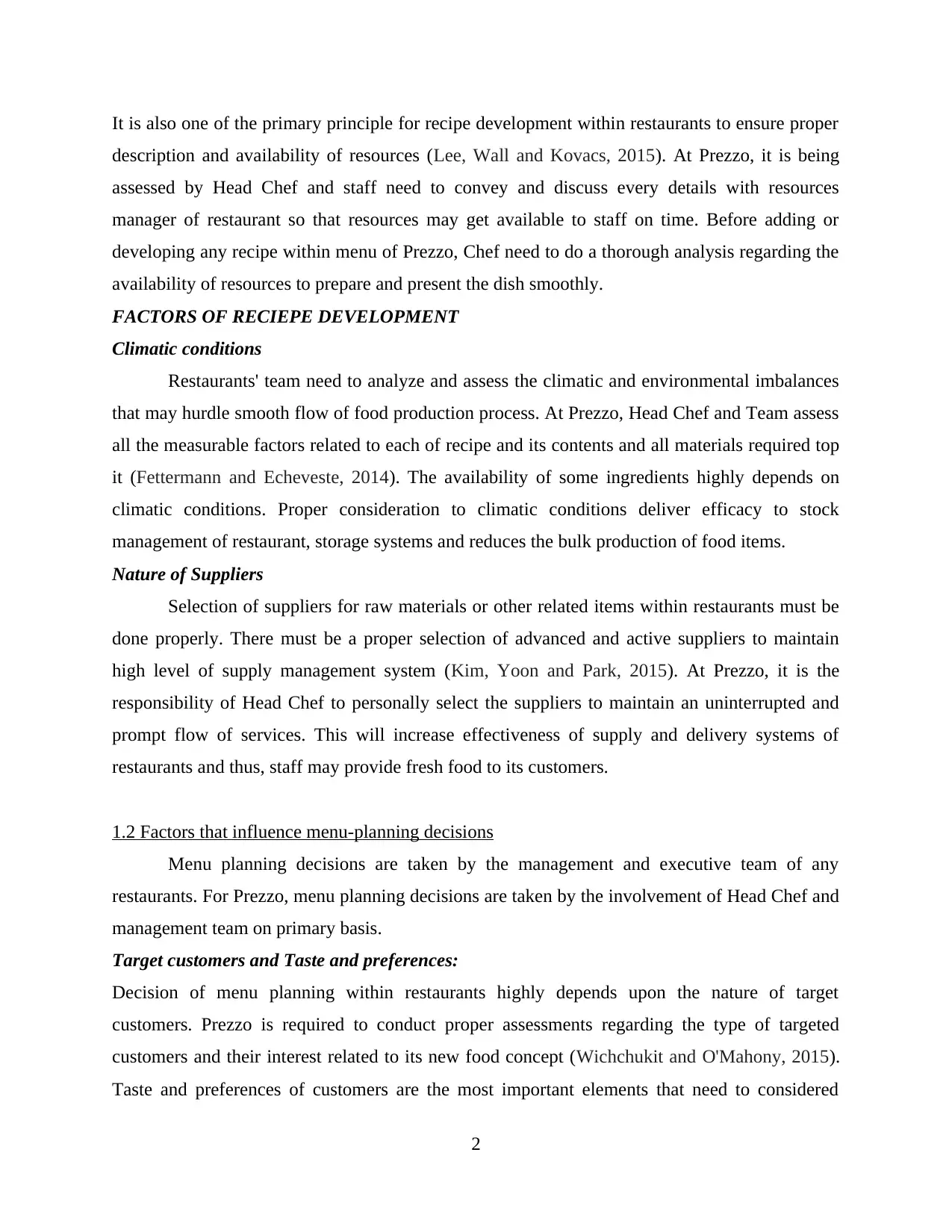
It is also one of the primary principle for recipe development within restaurants to ensure proper
description and availability of resources (Lee, Wall and Kovacs, 2015). At Prezzo, it is being
assessed by Head Chef and staff need to convey and discuss every details with resources
manager of restaurant so that resources may get available to staff on time. Before adding or
developing any recipe within menu of Prezzo, Chef need to do a thorough analysis regarding the
availability of resources to prepare and present the dish smoothly.
FACTORS OF RECIEPE DEVELOPMENT
Climatic conditions
Restaurants' team need to analyze and assess the climatic and environmental imbalances
that may hurdle smooth flow of food production process. At Prezzo, Head Chef and Team assess
all the measurable factors related to each of recipe and its contents and all materials required top
it (Fettermann and Echeveste, 2014). The availability of some ingredients highly depends on
climatic conditions. Proper consideration to climatic conditions deliver efficacy to stock
management of restaurant, storage systems and reduces the bulk production of food items.
Nature of Suppliers
Selection of suppliers for raw materials or other related items within restaurants must be
done properly. There must be a proper selection of advanced and active suppliers to maintain
high level of supply management system (Kim, Yoon and Park, 2015). At Prezzo, it is the
responsibility of Head Chef to personally select the suppliers to maintain an uninterrupted and
prompt flow of services. This will increase effectiveness of supply and delivery systems of
restaurants and thus, staff may provide fresh food to its customers.
1.2 Factors that influence menu-planning decisions
Menu planning decisions are taken by the management and executive team of any
restaurants. For Prezzo, menu planning decisions are taken by the involvement of Head Chef and
management team on primary basis.
Target customers and Taste and preferences:
Decision of menu planning within restaurants highly depends upon the nature of target
customers. Prezzo is required to conduct proper assessments regarding the type of targeted
customers and their interest related to its new food concept (Wichchukit and O'Mahony, 2015).
Taste and preferences of customers are the most important elements that need to considered
2
description and availability of resources (Lee, Wall and Kovacs, 2015). At Prezzo, it is being
assessed by Head Chef and staff need to convey and discuss every details with resources
manager of restaurant so that resources may get available to staff on time. Before adding or
developing any recipe within menu of Prezzo, Chef need to do a thorough analysis regarding the
availability of resources to prepare and present the dish smoothly.
FACTORS OF RECIEPE DEVELOPMENT
Climatic conditions
Restaurants' team need to analyze and assess the climatic and environmental imbalances
that may hurdle smooth flow of food production process. At Prezzo, Head Chef and Team assess
all the measurable factors related to each of recipe and its contents and all materials required top
it (Fettermann and Echeveste, 2014). The availability of some ingredients highly depends on
climatic conditions. Proper consideration to climatic conditions deliver efficacy to stock
management of restaurant, storage systems and reduces the bulk production of food items.
Nature of Suppliers
Selection of suppliers for raw materials or other related items within restaurants must be
done properly. There must be a proper selection of advanced and active suppliers to maintain
high level of supply management system (Kim, Yoon and Park, 2015). At Prezzo, it is the
responsibility of Head Chef to personally select the suppliers to maintain an uninterrupted and
prompt flow of services. This will increase effectiveness of supply and delivery systems of
restaurants and thus, staff may provide fresh food to its customers.
1.2 Factors that influence menu-planning decisions
Menu planning decisions are taken by the management and executive team of any
restaurants. For Prezzo, menu planning decisions are taken by the involvement of Head Chef and
management team on primary basis.
Target customers and Taste and preferences:
Decision of menu planning within restaurants highly depends upon the nature of target
customers. Prezzo is required to conduct proper assessments regarding the type of targeted
customers and their interest related to its new food concept (Wichchukit and O'Mahony, 2015).
Taste and preferences of customers are the most important elements that need to considered
2
Paraphrase This Document
Need a fresh take? Get an instant paraphrase of this document with our AI Paraphraser
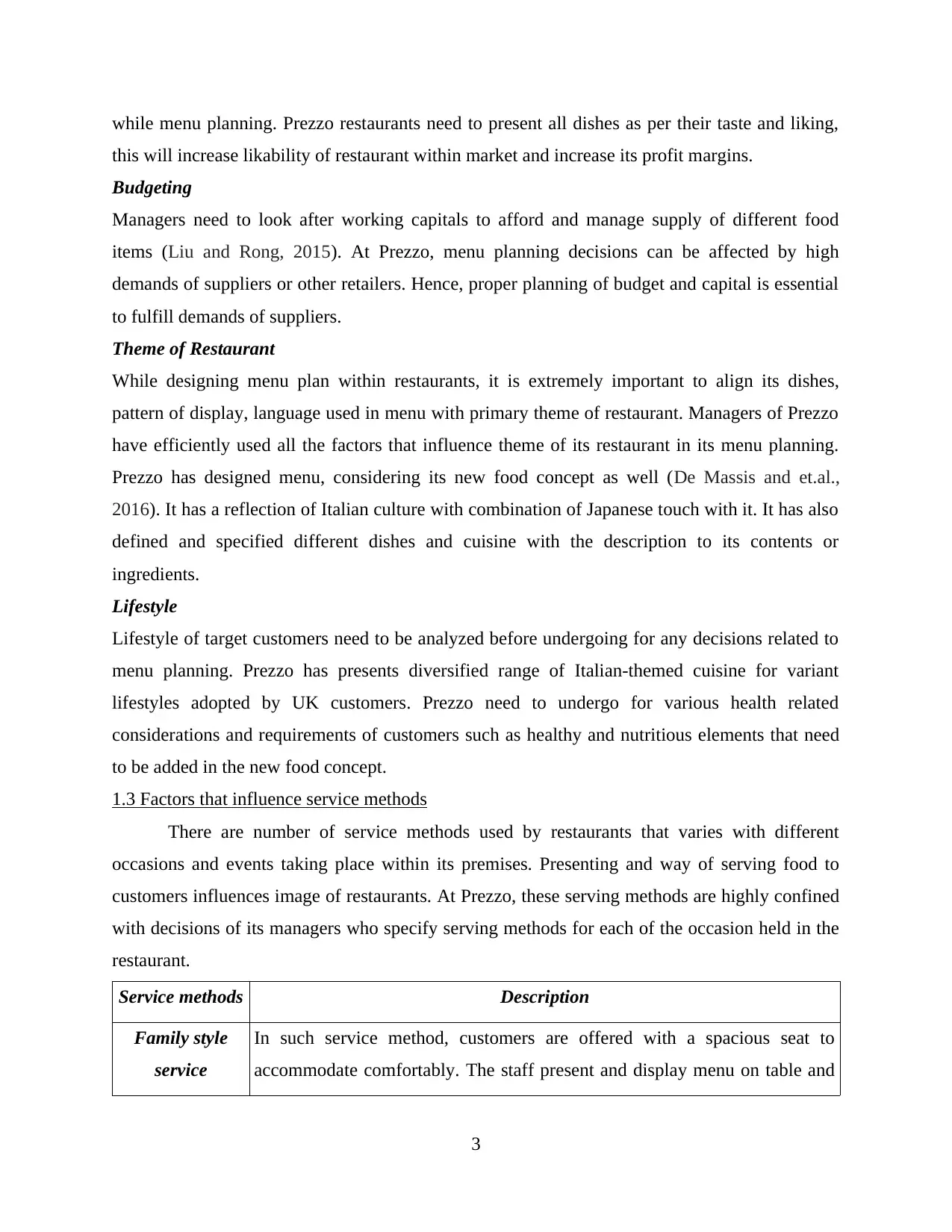
while menu planning. Prezzo restaurants need to present all dishes as per their taste and liking,
this will increase likability of restaurant within market and increase its profit margins.
Budgeting
Managers need to look after working capitals to afford and manage supply of different food
items (Liu and Rong, 2015). At Prezzo, menu planning decisions can be affected by high
demands of suppliers or other retailers. Hence, proper planning of budget and capital is essential
to fulfill demands of suppliers.
Theme of Restaurant
While designing menu plan within restaurants, it is extremely important to align its dishes,
pattern of display, language used in menu with primary theme of restaurant. Managers of Prezzo
have efficiently used all the factors that influence theme of its restaurant in its menu planning.
Prezzo has designed menu, considering its new food concept as well (De Massis and et.al.,
2016). It has a reflection of Italian culture with combination of Japanese touch with it. It has also
defined and specified different dishes and cuisine with the description to its contents or
ingredients.
Lifestyle
Lifestyle of target customers need to be analyzed before undergoing for any decisions related to
menu planning. Prezzo has presents diversified range of Italian-themed cuisine for variant
lifestyles adopted by UK customers. Prezzo need to undergo for various health related
considerations and requirements of customers such as healthy and nutritious elements that need
to be added in the new food concept.
1.3 Factors that influence service methods
There are number of service methods used by restaurants that varies with different
occasions and events taking place within its premises. Presenting and way of serving food to
customers influences image of restaurants. At Prezzo, these serving methods are highly confined
with decisions of its managers who specify serving methods for each of the occasion held in the
restaurant.
Service methods Description
Family style
service
In such service method, customers are offered with a spacious seat to
accommodate comfortably. The staff present and display menu on table and
3
this will increase likability of restaurant within market and increase its profit margins.
Budgeting
Managers need to look after working capitals to afford and manage supply of different food
items (Liu and Rong, 2015). At Prezzo, menu planning decisions can be affected by high
demands of suppliers or other retailers. Hence, proper planning of budget and capital is essential
to fulfill demands of suppliers.
Theme of Restaurant
While designing menu plan within restaurants, it is extremely important to align its dishes,
pattern of display, language used in menu with primary theme of restaurant. Managers of Prezzo
have efficiently used all the factors that influence theme of its restaurant in its menu planning.
Prezzo has designed menu, considering its new food concept as well (De Massis and et.al.,
2016). It has a reflection of Italian culture with combination of Japanese touch with it. It has also
defined and specified different dishes and cuisine with the description to its contents or
ingredients.
Lifestyle
Lifestyle of target customers need to be analyzed before undergoing for any decisions related to
menu planning. Prezzo has presents diversified range of Italian-themed cuisine for variant
lifestyles adopted by UK customers. Prezzo need to undergo for various health related
considerations and requirements of customers such as healthy and nutritious elements that need
to be added in the new food concept.
1.3 Factors that influence service methods
There are number of service methods used by restaurants that varies with different
occasions and events taking place within its premises. Presenting and way of serving food to
customers influences image of restaurants. At Prezzo, these serving methods are highly confined
with decisions of its managers who specify serving methods for each of the occasion held in the
restaurant.
Service methods Description
Family style
service
In such service method, customers are offered with a spacious seat to
accommodate comfortably. The staff present and display menu on table and
3
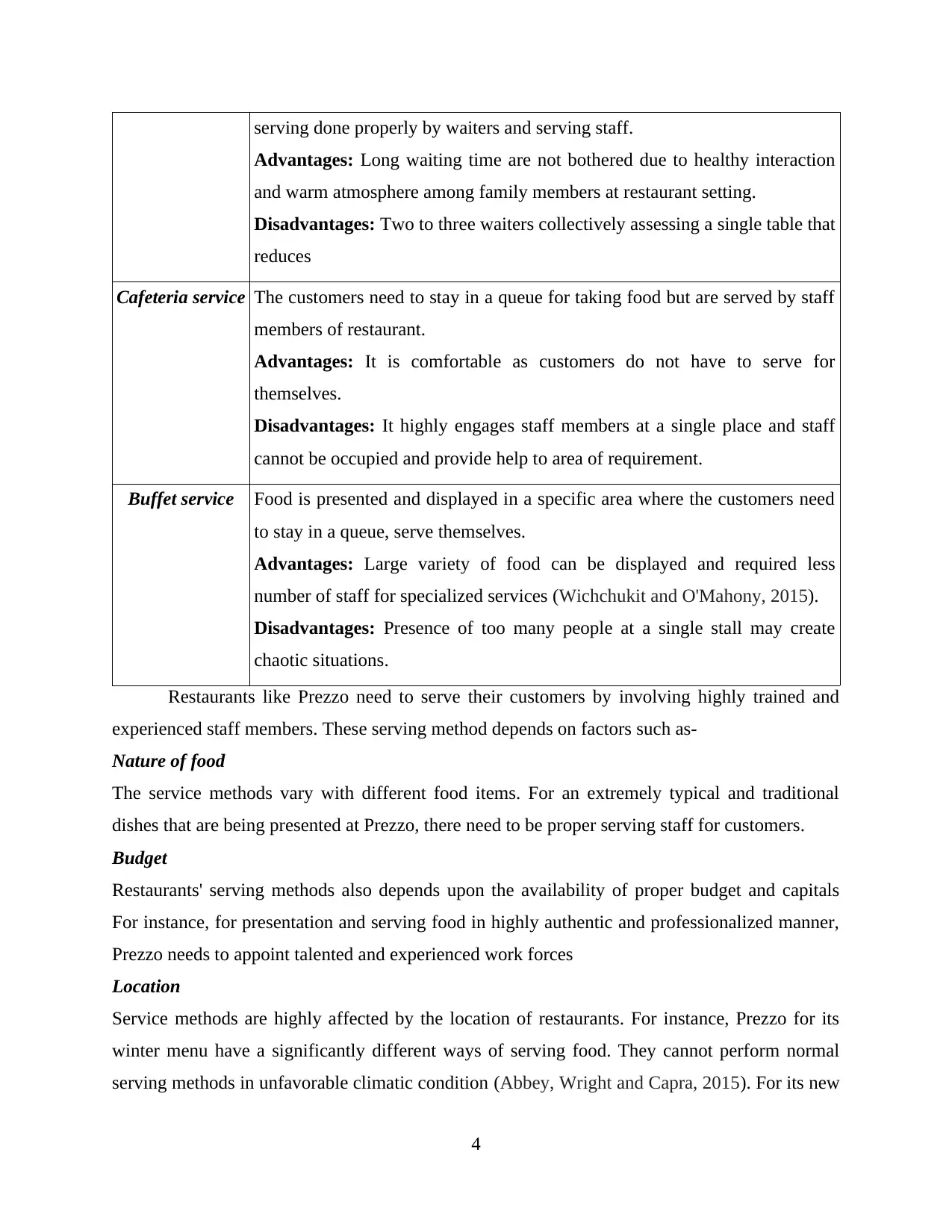
serving done properly by waiters and serving staff.
Advantages: Long waiting time are not bothered due to healthy interaction
and warm atmosphere among family members at restaurant setting.
Disadvantages: Two to three waiters collectively assessing a single table that
reduces
Cafeteria service The customers need to stay in a queue for taking food but are served by staff
members of restaurant.
Advantages: It is comfortable as customers do not have to serve for
themselves.
Disadvantages: It highly engages staff members at a single place and staff
cannot be occupied and provide help to area of requirement.
Buffet service Food is presented and displayed in a specific area where the customers need
to stay in a queue, serve themselves.
Advantages: Large variety of food can be displayed and required less
number of staff for specialized services (Wichchukit and O'Mahony, 2015).
Disadvantages: Presence of too many people at a single stall may create
chaotic situations.
Restaurants like Prezzo need to serve their customers by involving highly trained and
experienced staff members. These serving method depends on factors such as-
Nature of food
The service methods vary with different food items. For an extremely typical and traditional
dishes that are being presented at Prezzo, there need to be proper serving staff for customers.
Budget
Restaurants' serving methods also depends upon the availability of proper budget and capitals
For instance, for presentation and serving food in highly authentic and professionalized manner,
Prezzo needs to appoint talented and experienced work forces
Location
Service methods are highly affected by the location of restaurants. For instance, Prezzo for its
winter menu have a significantly different ways of serving food. They cannot perform normal
serving methods in unfavorable climatic condition (Abbey, Wright and Capra, 2015). For its new
4
Advantages: Long waiting time are not bothered due to healthy interaction
and warm atmosphere among family members at restaurant setting.
Disadvantages: Two to three waiters collectively assessing a single table that
reduces
Cafeteria service The customers need to stay in a queue for taking food but are served by staff
members of restaurant.
Advantages: It is comfortable as customers do not have to serve for
themselves.
Disadvantages: It highly engages staff members at a single place and staff
cannot be occupied and provide help to area of requirement.
Buffet service Food is presented and displayed in a specific area where the customers need
to stay in a queue, serve themselves.
Advantages: Large variety of food can be displayed and required less
number of staff for specialized services (Wichchukit and O'Mahony, 2015).
Disadvantages: Presence of too many people at a single stall may create
chaotic situations.
Restaurants like Prezzo need to serve their customers by involving highly trained and
experienced staff members. These serving method depends on factors such as-
Nature of food
The service methods vary with different food items. For an extremely typical and traditional
dishes that are being presented at Prezzo, there need to be proper serving staff for customers.
Budget
Restaurants' serving methods also depends upon the availability of proper budget and capitals
For instance, for presentation and serving food in highly authentic and professionalized manner,
Prezzo needs to appoint talented and experienced work forces
Location
Service methods are highly affected by the location of restaurants. For instance, Prezzo for its
winter menu have a significantly different ways of serving food. They cannot perform normal
serving methods in unfavorable climatic condition (Abbey, Wright and Capra, 2015). For its new
4
⊘ This is a preview!⊘
Do you want full access?
Subscribe today to unlock all pages.

Trusted by 1+ million students worldwide
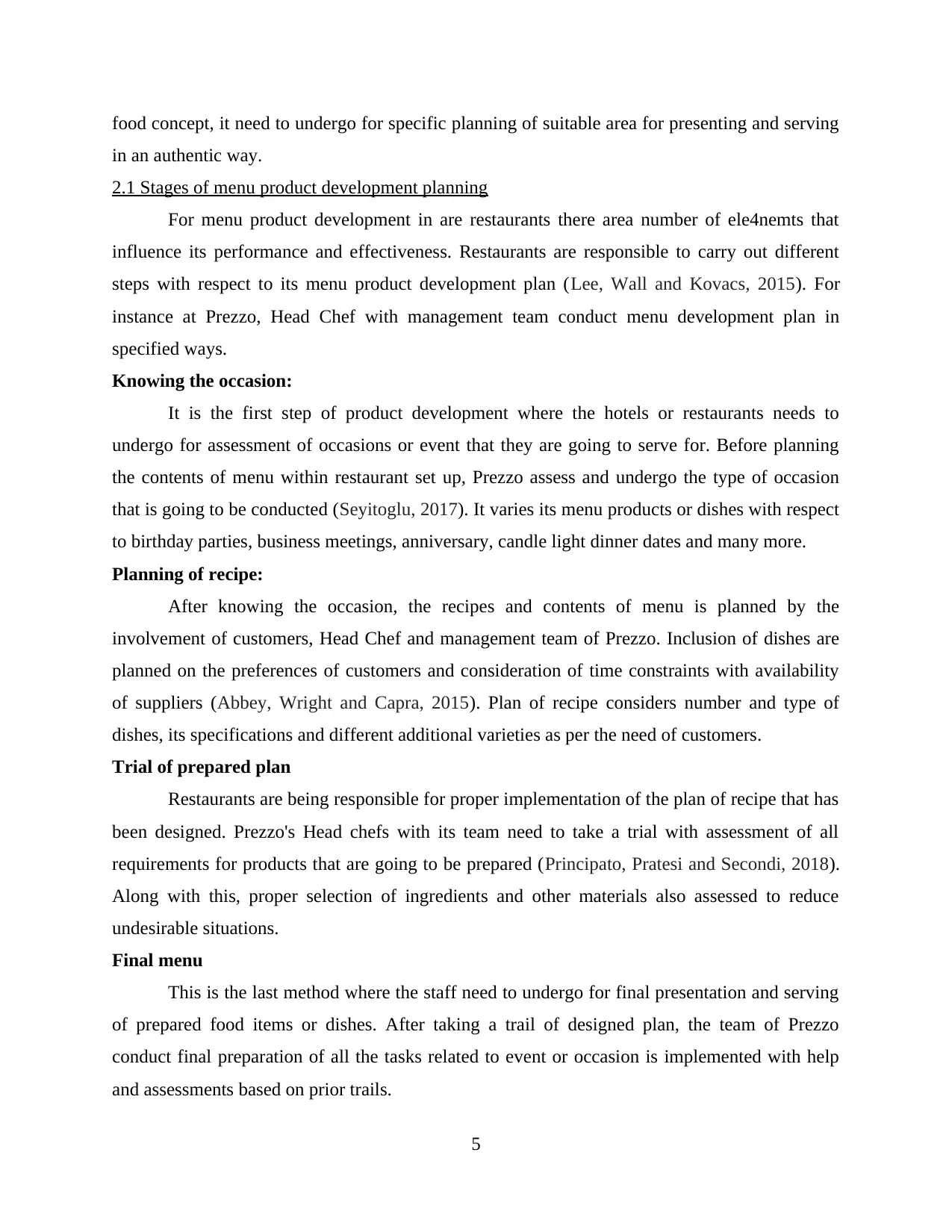
food concept, it need to undergo for specific planning of suitable area for presenting and serving
in an authentic way.
2.1 Stages of menu product development planning
For menu product development in are restaurants there area number of ele4nemts that
influence its performance and effectiveness. Restaurants are responsible to carry out different
steps with respect to its menu product development plan (Lee, Wall and Kovacs, 2015). For
instance at Prezzo, Head Chef with management team conduct menu development plan in
specified ways.
Knowing the occasion:
It is the first step of product development where the hotels or restaurants needs to
undergo for assessment of occasions or event that they are going to serve for. Before planning
the contents of menu within restaurant set up, Prezzo assess and undergo the type of occasion
that is going to be conducted (Seyitoglu, 2017). It varies its menu products or dishes with respect
to birthday parties, business meetings, anniversary, candle light dinner dates and many more.
Planning of recipe:
After knowing the occasion, the recipes and contents of menu is planned by the
involvement of customers, Head Chef and management team of Prezzo. Inclusion of dishes are
planned on the preferences of customers and consideration of time constraints with availability
of suppliers (Abbey, Wright and Capra, 2015). Plan of recipe considers number and type of
dishes, its specifications and different additional varieties as per the need of customers.
Trial of prepared plan
Restaurants are being responsible for proper implementation of the plan of recipe that has
been designed. Prezzo's Head chefs with its team need to take a trial with assessment of all
requirements for products that are going to be prepared (Principato, Pratesi and Secondi, 2018).
Along with this, proper selection of ingredients and other materials also assessed to reduce
undesirable situations.
Final menu
This is the last method where the staff need to undergo for final presentation and serving
of prepared food items or dishes. After taking a trail of designed plan, the team of Prezzo
conduct final preparation of all the tasks related to event or occasion is implemented with help
and assessments based on prior trails.
5
in an authentic way.
2.1 Stages of menu product development planning
For menu product development in are restaurants there area number of ele4nemts that
influence its performance and effectiveness. Restaurants are responsible to carry out different
steps with respect to its menu product development plan (Lee, Wall and Kovacs, 2015). For
instance at Prezzo, Head Chef with management team conduct menu development plan in
specified ways.
Knowing the occasion:
It is the first step of product development where the hotels or restaurants needs to
undergo for assessment of occasions or event that they are going to serve for. Before planning
the contents of menu within restaurant set up, Prezzo assess and undergo the type of occasion
that is going to be conducted (Seyitoglu, 2017). It varies its menu products or dishes with respect
to birthday parties, business meetings, anniversary, candle light dinner dates and many more.
Planning of recipe:
After knowing the occasion, the recipes and contents of menu is planned by the
involvement of customers, Head Chef and management team of Prezzo. Inclusion of dishes are
planned on the preferences of customers and consideration of time constraints with availability
of suppliers (Abbey, Wright and Capra, 2015). Plan of recipe considers number and type of
dishes, its specifications and different additional varieties as per the need of customers.
Trial of prepared plan
Restaurants are being responsible for proper implementation of the plan of recipe that has
been designed. Prezzo's Head chefs with its team need to take a trial with assessment of all
requirements for products that are going to be prepared (Principato, Pratesi and Secondi, 2018).
Along with this, proper selection of ingredients and other materials also assessed to reduce
undesirable situations.
Final menu
This is the last method where the staff need to undergo for final presentation and serving
of prepared food items or dishes. After taking a trail of designed plan, the team of Prezzo
conduct final preparation of all the tasks related to event or occasion is implemented with help
and assessments based on prior trails.
5
Paraphrase This Document
Need a fresh take? Get an instant paraphrase of this document with our AI Paraphraser
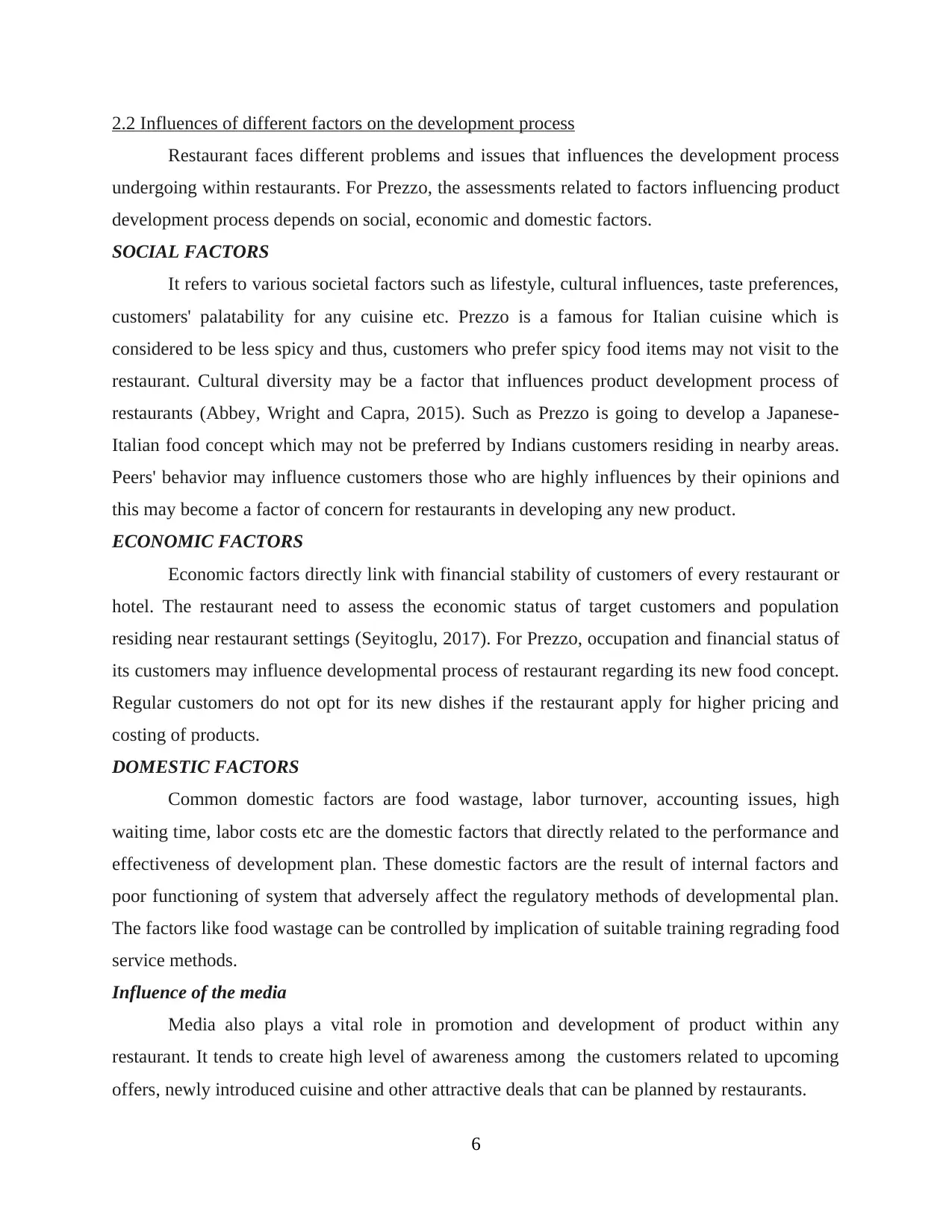
2.2 Influences of different factors on the development process
Restaurant faces different problems and issues that influences the development process
undergoing within restaurants. For Prezzo, the assessments related to factors influencing product
development process depends on social, economic and domestic factors.
SOCIAL FACTORS
It refers to various societal factors such as lifestyle, cultural influences, taste preferences,
customers' palatability for any cuisine etc. Prezzo is a famous for Italian cuisine which is
considered to be less spicy and thus, customers who prefer spicy food items may not visit to the
restaurant. Cultural diversity may be a factor that influences product development process of
restaurants (Abbey, Wright and Capra, 2015). Such as Prezzo is going to develop a Japanese-
Italian food concept which may not be preferred by Indians customers residing in nearby areas.
Peers' behavior may influence customers those who are highly influences by their opinions and
this may become a factor of concern for restaurants in developing any new product.
ECONOMIC FACTORS
Economic factors directly link with financial stability of customers of every restaurant or
hotel. The restaurant need to assess the economic status of target customers and population
residing near restaurant settings (Seyitoglu, 2017). For Prezzo, occupation and financial status of
its customers may influence developmental process of restaurant regarding its new food concept.
Regular customers do not opt for its new dishes if the restaurant apply for higher pricing and
costing of products.
DOMESTIC FACTORS
Common domestic factors are food wastage, labor turnover, accounting issues, high
waiting time, labor costs etc are the domestic factors that directly related to the performance and
effectiveness of development plan. These domestic factors are the result of internal factors and
poor functioning of system that adversely affect the regulatory methods of developmental plan.
The factors like food wastage can be controlled by implication of suitable training regrading food
service methods.
Influence of the media
Media also plays a vital role in promotion and development of product within any
restaurant. It tends to create high level of awareness among the customers related to upcoming
offers, newly introduced cuisine and other attractive deals that can be planned by restaurants.
6
Restaurant faces different problems and issues that influences the development process
undergoing within restaurants. For Prezzo, the assessments related to factors influencing product
development process depends on social, economic and domestic factors.
SOCIAL FACTORS
It refers to various societal factors such as lifestyle, cultural influences, taste preferences,
customers' palatability for any cuisine etc. Prezzo is a famous for Italian cuisine which is
considered to be less spicy and thus, customers who prefer spicy food items may not visit to the
restaurant. Cultural diversity may be a factor that influences product development process of
restaurants (Abbey, Wright and Capra, 2015). Such as Prezzo is going to develop a Japanese-
Italian food concept which may not be preferred by Indians customers residing in nearby areas.
Peers' behavior may influence customers those who are highly influences by their opinions and
this may become a factor of concern for restaurants in developing any new product.
ECONOMIC FACTORS
Economic factors directly link with financial stability of customers of every restaurant or
hotel. The restaurant need to assess the economic status of target customers and population
residing near restaurant settings (Seyitoglu, 2017). For Prezzo, occupation and financial status of
its customers may influence developmental process of restaurant regarding its new food concept.
Regular customers do not opt for its new dishes if the restaurant apply for higher pricing and
costing of products.
DOMESTIC FACTORS
Common domestic factors are food wastage, labor turnover, accounting issues, high
waiting time, labor costs etc are the domestic factors that directly related to the performance and
effectiveness of development plan. These domestic factors are the result of internal factors and
poor functioning of system that adversely affect the regulatory methods of developmental plan.
The factors like food wastage can be controlled by implication of suitable training regrading food
service methods.
Influence of the media
Media also plays a vital role in promotion and development of product within any
restaurant. It tends to create high level of awareness among the customers related to upcoming
offers, newly introduced cuisine and other attractive deals that can be planned by restaurants.
6
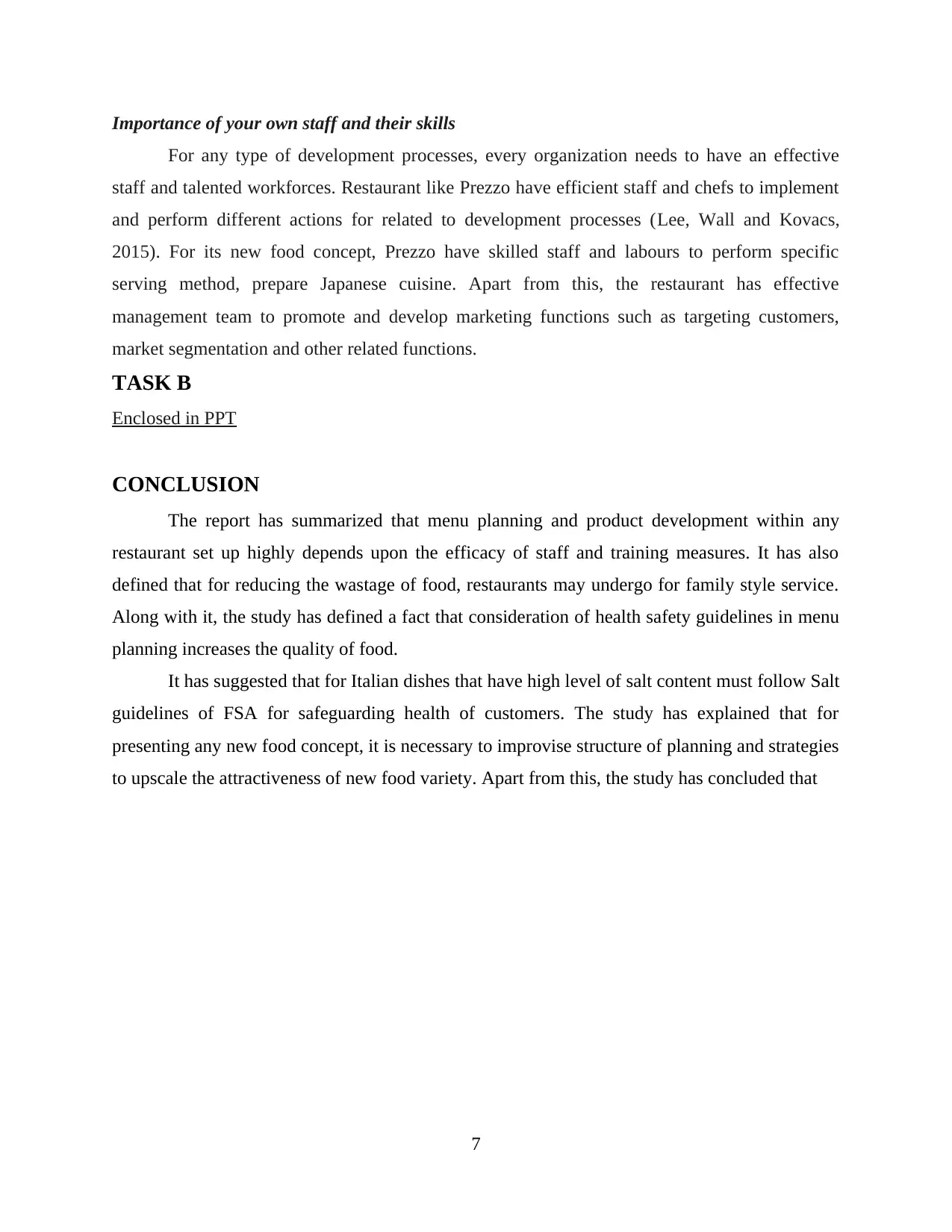
Importance of your own staff and their skills
For any type of development processes, every organization needs to have an effective
staff and talented workforces. Restaurant like Prezzo have efficient staff and chefs to implement
and perform different actions for related to development processes (Lee, Wall and Kovacs,
2015). For its new food concept, Prezzo have skilled staff and labours to perform specific
serving method, prepare Japanese cuisine. Apart from this, the restaurant has effective
management team to promote and develop marketing functions such as targeting customers,
market segmentation and other related functions.
TASK B
Enclosed in PPT
CONCLUSION
The report has summarized that menu planning and product development within any
restaurant set up highly depends upon the efficacy of staff and training measures. It has also
defined that for reducing the wastage of food, restaurants may undergo for family style service.
Along with it, the study has defined a fact that consideration of health safety guidelines in menu
planning increases the quality of food.
It has suggested that for Italian dishes that have high level of salt content must follow Salt
guidelines of FSA for safeguarding health of customers. The study has explained that for
presenting any new food concept, it is necessary to improvise structure of planning and strategies
to upscale the attractiveness of new food variety. Apart from this, the study has concluded that
7
For any type of development processes, every organization needs to have an effective
staff and talented workforces. Restaurant like Prezzo have efficient staff and chefs to implement
and perform different actions for related to development processes (Lee, Wall and Kovacs,
2015). For its new food concept, Prezzo have skilled staff and labours to perform specific
serving method, prepare Japanese cuisine. Apart from this, the restaurant has effective
management team to promote and develop marketing functions such as targeting customers,
market segmentation and other related functions.
TASK B
Enclosed in PPT
CONCLUSION
The report has summarized that menu planning and product development within any
restaurant set up highly depends upon the efficacy of staff and training measures. It has also
defined that for reducing the wastage of food, restaurants may undergo for family style service.
Along with it, the study has defined a fact that consideration of health safety guidelines in menu
planning increases the quality of food.
It has suggested that for Italian dishes that have high level of salt content must follow Salt
guidelines of FSA for safeguarding health of customers. The study has explained that for
presenting any new food concept, it is necessary to improvise structure of planning and strategies
to upscale the attractiveness of new food variety. Apart from this, the study has concluded that
7
⊘ This is a preview!⊘
Do you want full access?
Subscribe today to unlock all pages.

Trusted by 1+ million students worldwide
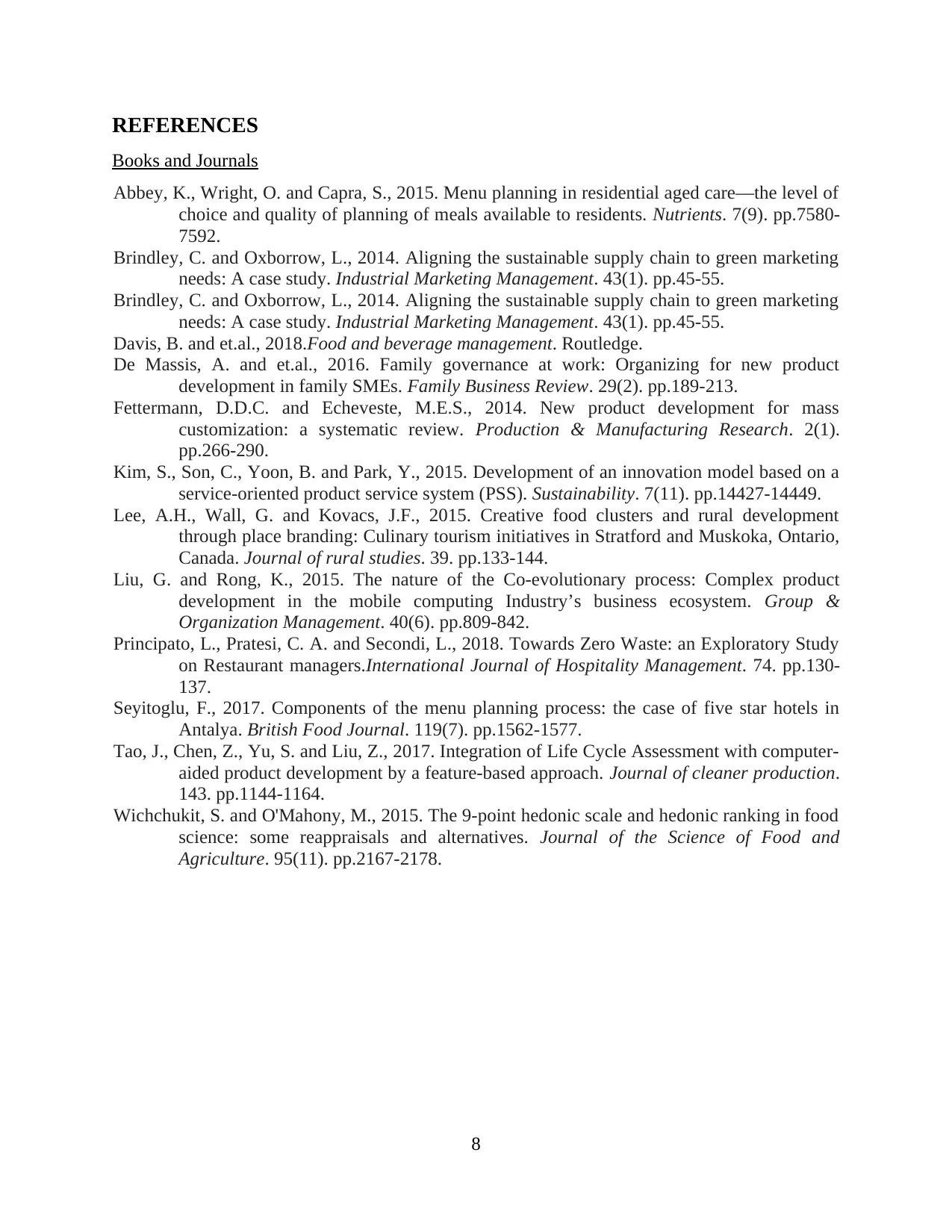
REFERENCES
Books and Journals
Abbey, K., Wright, O. and Capra, S., 2015. Menu planning in residential aged care—the level of
choice and quality of planning of meals available to residents. Nutrients. 7(9). pp.7580-
7592.
Brindley, C. and Oxborrow, L., 2014. Aligning the sustainable supply chain to green marketing
needs: A case study. Industrial Marketing Management. 43(1). pp.45-55.
Brindley, C. and Oxborrow, L., 2014. Aligning the sustainable supply chain to green marketing
needs: A case study. Industrial Marketing Management. 43(1). pp.45-55.
Davis, B. and et.al., 2018.Food and beverage management. Routledge.
De Massis, A. and et.al., 2016. Family governance at work: Organizing for new product
development in family SMEs. Family Business Review. 29(2). pp.189-213.
Fettermann, D.D.C. and Echeveste, M.E.S., 2014. New product development for mass
customization: a systematic review. Production & Manufacturing Research. 2(1).
pp.266-290.
Kim, S., Son, C., Yoon, B. and Park, Y., 2015. Development of an innovation model based on a
service-oriented product service system (PSS). Sustainability. 7(11). pp.14427-14449.
Lee, A.H., Wall, G. and Kovacs, J.F., 2015. Creative food clusters and rural development
through place branding: Culinary tourism initiatives in Stratford and Muskoka, Ontario,
Canada. Journal of rural studies. 39. pp.133-144.
Liu, G. and Rong, K., 2015. The nature of the Co-evolutionary process: Complex product
development in the mobile computing Industry’s business ecosystem. Group &
Organization Management. 40(6). pp.809-842.
Principato, L., Pratesi, C. A. and Secondi, L., 2018. Towards Zero Waste: an Exploratory Study
on Restaurant managers.International Journal of Hospitality Management. 74. pp.130-
137.
Seyitoglu, F., 2017. Components of the menu planning process: the case of five star hotels in
Antalya. British Food Journal. 119(7). pp.1562-1577.
Tao, J., Chen, Z., Yu, S. and Liu, Z., 2017. Integration of Life Cycle Assessment with computer-
aided product development by a feature-based approach. Journal of cleaner production.
143. pp.1144-1164.
Wichchukit, S. and O'Mahony, M., 2015. The 9‐point hedonic scale and hedonic ranking in food
science: some reappraisals and alternatives. Journal of the Science of Food and
Agriculture. 95(11). pp.2167-2178.
8
Books and Journals
Abbey, K., Wright, O. and Capra, S., 2015. Menu planning in residential aged care—the level of
choice and quality of planning of meals available to residents. Nutrients. 7(9). pp.7580-
7592.
Brindley, C. and Oxborrow, L., 2014. Aligning the sustainable supply chain to green marketing
needs: A case study. Industrial Marketing Management. 43(1). pp.45-55.
Brindley, C. and Oxborrow, L., 2014. Aligning the sustainable supply chain to green marketing
needs: A case study. Industrial Marketing Management. 43(1). pp.45-55.
Davis, B. and et.al., 2018.Food and beverage management. Routledge.
De Massis, A. and et.al., 2016. Family governance at work: Organizing for new product
development in family SMEs. Family Business Review. 29(2). pp.189-213.
Fettermann, D.D.C. and Echeveste, M.E.S., 2014. New product development for mass
customization: a systematic review. Production & Manufacturing Research. 2(1).
pp.266-290.
Kim, S., Son, C., Yoon, B. and Park, Y., 2015. Development of an innovation model based on a
service-oriented product service system (PSS). Sustainability. 7(11). pp.14427-14449.
Lee, A.H., Wall, G. and Kovacs, J.F., 2015. Creative food clusters and rural development
through place branding: Culinary tourism initiatives in Stratford and Muskoka, Ontario,
Canada. Journal of rural studies. 39. pp.133-144.
Liu, G. and Rong, K., 2015. The nature of the Co-evolutionary process: Complex product
development in the mobile computing Industry’s business ecosystem. Group &
Organization Management. 40(6). pp.809-842.
Principato, L., Pratesi, C. A. and Secondi, L., 2018. Towards Zero Waste: an Exploratory Study
on Restaurant managers.International Journal of Hospitality Management. 74. pp.130-
137.
Seyitoglu, F., 2017. Components of the menu planning process: the case of five star hotels in
Antalya. British Food Journal. 119(7). pp.1562-1577.
Tao, J., Chen, Z., Yu, S. and Liu, Z., 2017. Integration of Life Cycle Assessment with computer-
aided product development by a feature-based approach. Journal of cleaner production.
143. pp.1144-1164.
Wichchukit, S. and O'Mahony, M., 2015. The 9‐point hedonic scale and hedonic ranking in food
science: some reappraisals and alternatives. Journal of the Science of Food and
Agriculture. 95(11). pp.2167-2178.
8
1 out of 10
Related Documents
Your All-in-One AI-Powered Toolkit for Academic Success.
+13062052269
info@desklib.com
Available 24*7 on WhatsApp / Email
![[object Object]](/_next/static/media/star-bottom.7253800d.svg)
Unlock your academic potential
Copyright © 2020–2025 A2Z Services. All Rights Reserved. Developed and managed by ZUCOL.





